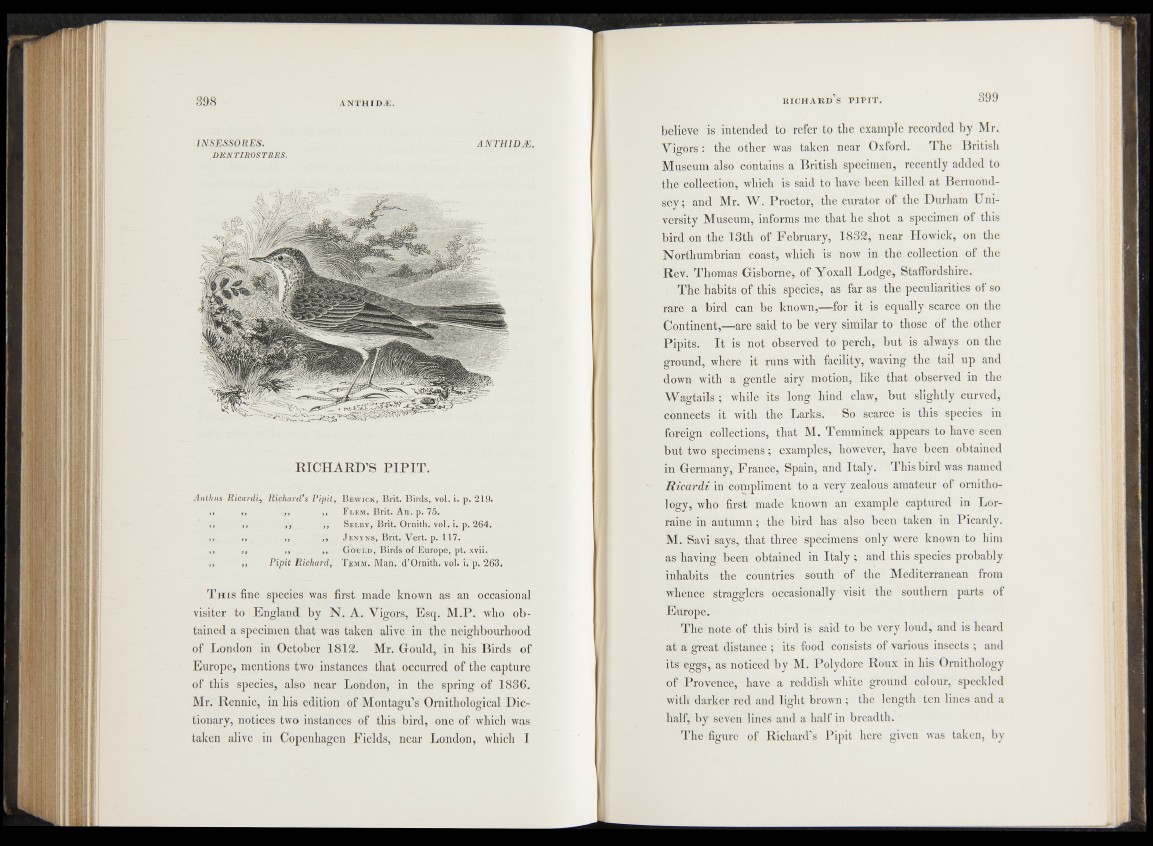
1NSESS0RES. ANTHIDJE.
DENTIROSTRES.
RICHARD’S P IP IT .
Anthus llicardi, Richard’s Pipit, B ewick, Brit. Birds, vol. i. p. 219.
,, ,, ,, ,, F lem. Brit. An. p. 75.
,, ,, , , ,, Selby, Brit. Ornith. vol. i. p. 264.
,, ,, ,, ,, J enyns, Brit. Vert. p. 117.
,, ,, ,, ,, G ould, Birds of Europe, pt. xvii.
,, ,, Pipit Richard, T emm. Man. d’Ornith. vol. i. p. 263.
T h i s fine species was first made known as an occasional
visiter to England by N. A. Vigors, Esq. M.P. who obtained
a specimen that was taken alive in the neighbourhood
of London in October 1812. Mr. Gould, in his Birds of
Europe, mentions two instances that occurred of the capture
of this species, also near London, in the spring of 1836.
Mr. Rennie, in his edition of Montagu’s Ornithological Dictionary,
notices two instances of this bird, one of which was
taken alive in Copenhagen Fields, near London, which I
believe is intended to refer to the example recorded by Mr.
Vigors : the other was taken near Oxford. The British
Museum also contains a British specimen, recently added to
the collection, which is said to have been killed at Bermondsey;
and Mr. W. Proctor, the curator of the Durham University
Museum, informs me that he shot a specimen of this
bird on the 13th of February, 1832, near Howick, on the
Northumbrian coast, which is now in the collection of the
Rev. Thomas Gisborne, of Yoxall Lodge, Staffordshire.
The habits of this species, as far as the peculiarities of so
rare a bird can be known,—for it is equally scarce on the
Continent,—are said to be very similar to those of the other
Pipits. It is not observed to perch, but is always on the
ground, where it runs with facility, waving the tail up and
down with a gentle airy motion, like that observed in the
Wagtails ; while its long hind claw, but slightly curved,
connects it with the Larks. So scarce is this species in
foreign collections, that M. Temminck appears to have seen
but two specimens; examples, however, have been obtained
in Germany, France, Spain, and Italy. This bird was named
Ricardi in compliment to a very zealous amateur of ornithology,
who first made known an example captured in Lorraine
in autumn; the bird has also been taken in Picardy.
M. Savi says, that three specimens only were known to him
as having been obtained in Italy ; and this species probably
inhabits the countries south of the Mediterranean from
whence stragglers occasionally visit the southern parts of
Europe.
The note of this bird is said to be very loud, and is heard
at a great distance ; its food consists of various insects ; and
its eggs, as noticed by M. Polydore Roux in his Ornithology
of Provence, have a reddish white ground colour, speckled
with darker red and light brown ; the length ten lines and a
half, by seven lines and a half in breadth.
The figure of Richard’s Pipit here given was taken, by